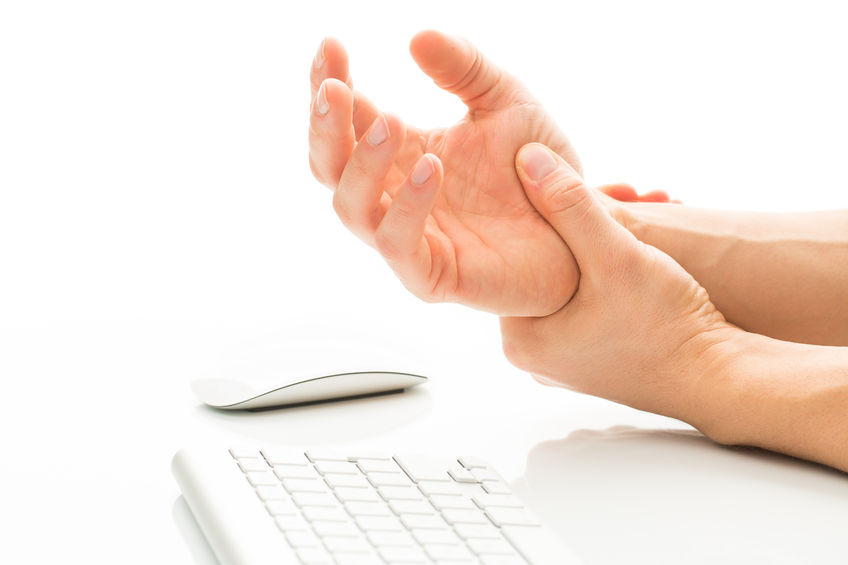
Carpal Tunnel Syndrome
Do your fingers feel numb or tingly when you perform strenuous activities with your hands? Do you wake up during the night because your hands feel like they are asleep and you need to shake them out to get the feeling back? If you answered yes, you may be experiencing symptoms of carpal tunnel syndrome (CTS) which affects 4-10 million people annually.
Carpal tunnel syndrome is a common nerve disorder caused by compression of the median nerve as it passes through the wrist in a narrow passageway called the carpal tunnel. The median nerve travels from your neck down the arm and through this tunnel, providing sensation to the thumb, index, middle and half of the ring finger and also sends impulses to the muscles in the palm that control certain thumb motions. Passing through this tunnel, whose space is limited by bones on three sides and a tight ligament on the fourth, along with the median nerve are nine tendons that function to flex the fingers and the thumb. Inflammation or swelling within this confined space compresses the median nerve, resulting in symptoms of pain, numbness and tingling.
The symptoms of CTS usually start gradually, but will usually progress without treatment. Symptoms are aggravated by activities that put the wrist in a flexed or extended position for a prolonged period of time. Pain can sometimes radiate up into the shoulder or, as described above, patients can experience symptoms at night that awakened them from sleep. As symptoms worsen, people typically begin to have difficulty grasping objects and notice a decrease in grip strength. Some atrophy of the thumb muscles can occur in the late stages due to some permanent nerve damage.
Rather than a problem with the nerve itself, CTS is often caused by multiple factors that increase pressure on the median nerve and tendons. CTS may be found in patients with a variety of medical conditions, but just as frequently the syndrome occurs on its own. Whether repetitive work activities cause carpal tunnel syndrome is still controversial, but it is thought that some strenuous repetitive hand activities, especially those involving vibratory motion, can worsen the symptoms. There may be a genetic predisposition in some, meaning they simply have a smaller carpal tunnel.
Early diagnosis and treatment of CTS are important to avoid permanent damage to the median nerve. A physical examination of the hands, arms, shoulders, and neck can help determine if the patient’s complaints are related to daily activities or to an underlying disorder and can rule out other conditions that mimic CTS. Routine laboratory tests may be performed to help identify other medical conditions. Electrodiagnostic tests may be used to confirm diagnosis. In a nerve conduction study, electrodes are placed on the hand and wrist. Small electric shocks are applied and the speed with which nerves transmit impulses is measured. In electromyography, a fine needle is inserted into a muscle; electrical activity viewed on a screen can determine the severity of damage.
Treatments should begin as early as possible under a doctor’s direction. Underlying causes such as diabetes or arthritis should be treated first. Initial treatment generally involves two weeks rest of the affected hand and immobilizing the wrist in a splint. Inflammation is treated with cool packs and/or anti-inflammatory medications. Steroids are sometimes injected directly into the carpal tunnel to provide temporary relief. Most experts agree that if symptoms persist after six months of these conservative measures, surgery may be recommended to relieve the pressure on the median nerve.
Both of the surgical options to treat CTS involve transecting the tight ligament that forms the roof of the tunnel which relieves pressure on the median nerve and increases the volume inside the carpal tunnel. The traditional open technique involves making a 1-2 inch incision in the wrist directly over the ligament and then cutting the ligament. The endoscopic technique involves a smaller incision proximal to the ligament. Then a small camera is inserted into the carpal tunnel to view the bottom surface of the ligament which is then cut under direct vision. The advantage to endoscopic surgery is less scaring and patients usually to return to their normal activities sooner than with the open technique. Both procedures can be done on an outpatient basis with minimal or no sedation and local anesthesia. Although symptoms may be relieved immediately after the surgery, most patients experience some tenderness in the palm that takes a couple of months to completely resolve. Sometimes, a short course of supervised hand therapy is helpful. Most patients are able to return to normal activities within two weeks of surgery, but the length of recovery varies based on how long the patient has had symptoms and how badly the median nerve was damaged.


